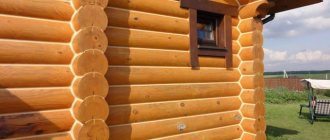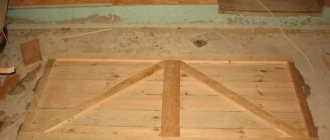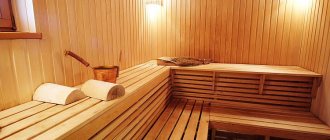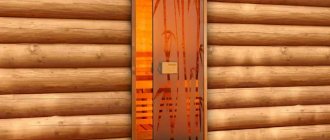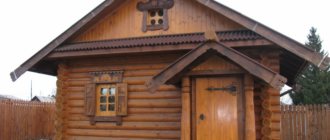Wooden doors
Wooden doors look aesthetically pleasing and elegant. There are many opportunities to buy blanks for painting or varnishing. It's cheap and practical. You can paint the old product in the desired tone that matches the interior. Many people wonder what is used to cover solid wood doors. There are many upgrade options. The only thing that is necessary is to adhere to the technology of preparing the canvas and painting.
Solid pine surface covered with enamel
How can you paint wooden doors?
How to paint a wooden door Today the question is “How to paint a wooden door in an apartment?” is not very relevant, because the market for paints and varnishes is quite diverse. But before you paint an interior wooden door in your house, you need to think about whether you need to preserve the structure of the natural material, or whether you need to completely mask the grain of the wood by painting the canvas with an opaque layer. Taking your own wishes as a basis, pay attention to the following paintwork materials:
- Enamels with an opaque base.
- Oil based paints.
- Transparent or tinted varnish.
- Oil based impregnations.
- Stain.
- Other paints and varnishes that can refresh the color of wood or give it a beautiful, correct shade.
The table below shows the classification of coatings.
| Classification: | Varieties: | |||
| View: | Varnish. | Dye. | Impregnation. | |
| Chemical composition: | Organic base. | Water based. | ||
| Mode of application: | Internal. | Outdoor. | Combined. | |
| Protective effect: | From changes in temperature and moisture. | From mechanical damage. | From chemical and organic irritants. | |
Of course, how to paint an old wooden door is up to you, but it’s worth listening to the opinions of experienced craftsmen. Many finishers recommend:
- Water-based acrylic material (substances containing acrylic have the most optimal consistency, which is important when working with brushes, and also spread well over the surface);
- Alkyd material (has a good ability to repel moisture, is not afraid of the sun, frost and sudden changes in temperature, dries quickly).
Wooden door painted with acrylic paint
If you need to treat the door to the bathhouse, it is better to choose alkyd paint for outdoor street work, which is less susceptible to adverse factors. Using such material, it will be possible to cover the doors to the house, as well as interior blocks.
If you are wondering “how to paint a wooden door in a country house or in an apartment?”, you should already understand that applying paint is not carried out in one stage. Sometimes, to get the desired effect, you have to use different formulations. Initially, specialists use impregnation, which can give a certain tone to the door, after which they apply a decorative layer.
Material Compatibility
It is not so easy to understand the modern variety of materials. Chemical compositions for the uninitiated person are a secret behind seven locks, and when buying a material to apply to old paint, many rely on luck, hoping that the old layer will not react in any way to contact with the new chemical. There are some recommendations according to which you should select the material depending on what the door is painted with.
Variety of colors
Therefore, before you go for paint, you need to clarify what the canvas is painted with.
- Epoxy and polyurethane compounds contain aggressive solvents. Cyclohexanone or xylene are capable of destroying materials that are reversible polymers obtained by natural curing (nitrocellulose, vinyl, copolymer-vinyl chloride compounds). Simply put, epoxy or polyurethane paint will destroy the coating made with nitro paints.
- Epoxy and polyurethane materials are applied only over the same compositions or primers, maintaining drying intervals for each layer.
- Silicate compounds are generally not applied over any other types of paints.
- Alkyd paints are not aggressive and can be safely applied over any material.
- Copolymer-vinyl chloride compounds and compounds based on chlorine rubber are applied only over acrylic, epoxy, and silicate materials.
Compatibility table
Despite the recommendations of the material compatibility table, it is better to use an experimental test: apply the new material to a small area of the canvas and see the reaction.
Features of painting door panels
Any wood is suitable for coating with stain: pine, oak, birch. It should be applied generously so that the surface is saturated. After the wood has absorbed the stain, you need to remove the residue. For washing, use a brush and acetone. It is necessary to carry out this procedure until the composition stops being washed off. After this, the door should dry well.
Varnishing is carried out in two stages. After the first layer has been applied, you need to wait for it to dry and remove any roughness and unevenness with sandpaper. After this, it will be necessary to varnish the coating again.
It often happens that old doorways have a good frame and panel, but have lost their original luster. An affordable, simple method of updating is coating with coloring materials. Any person can handle this kind of work. It is enough to know the properties of the paint and varnish materials from which the doors are made. Attention is paid to compliance with the technology of painting structures:
- Paneled canvases. Before painting, they are disassembled into elements, since the number of joints leads to wear and requires updating.
- Solid wood: heavy structures that convey the natural structure of wood. To update, use varnish or paint for such wood-look doors.
With varnish applied
- MDF. Painting the structure is simple, but before doing this, carefully prepare the surface.
Paint selection
So that the work does not go in vain, and the product turns out professional and stylish, you need to take a responsible approach to the issue of choosing raw materials.
The paint options you purchase may vary in many ways.
Various options for painting wooden doors
One of these parameters is the quality of the material:
- If you need to tidy up the existing surface without hiding the beauty of the material, you can cover the door leaf:
- some people prefer to use stain;
- others buy clear varnishes that renew the existing surface;
- still others choose oil-based impregnations;
- The canvases are also opened with tinting varnishes.
If you want to paint a white door like wood and achieve an imitation of wood, then you should pay attention to such finishing materials as:
- acrylic paint;
- oil paint;
- You can also paint MDF or wooden doors with polyurethane paint;
- perchlorvinyl paint is also suitable for this mission.
The choice of paint also depends on the material of the structure. In this case, the division goes to:
- Wooden doors. They can be painted with any paint you like.
- MDF or veneer surface. For these types of door structures, light, non-aggressive materials and paints are used. It is better to give preference to compounds that are marked that they are suitable for finishing MDF and veneer.
You should consider the type of material that will be used for finishing at the planning stage. This will help you avoid getting into a difficult situation when purchasing raw materials.
Sequence of work
The door structure is not only the door itself, so it is very important to carefully carry out the preparatory process. Of course, you can repaint only the canvas, but this way the jambs will fall out of the overall picture. And so, the process of painting the door should be carried out in the following sequence:
- The door structure is removed and placed on a stable surface (optionally, a pair of stools). If alkyd paint is used for work, it is better to move the work to the open air, because such paints and varnishes have a pungent odor.
Preparing a wooden door for painting
- Then, without removing the canvas itself, it is fixed with wedges so that the paneled brush has access to all hard-to-reach places. It is also necessary to block the doors so that during the drying process the doors do not slam shut and damage the new layer of paint.
Whatever route you take, you will still have to dismantle the fittings. If there are permanent parts, they can be hidden under paper or foil.
Coloring technologies in detail
Having processed the door leaf, you can start painting. When carrying out work, several rules must be taken into account:
- apply paint in 3 layers;
- Apply each new layer after the previous one has dried;
- paint doors with panels with a brush, immediately removing excess;
- roll panel wooden doors;
- Place the initial layer from the upper left to the lower right, the second from top to bottom, the final layer from right to left;
- Before work, rub and fluff the paint brush so that loose bristles come out.
Alkyd enamel
If the door is on hinges, then paint from top to bottom, moving the brush left and right: this way the drops will not flow onto the painted part of the surface. If the door is removed from its hinges and lies on a horizontal stand, then you can start painting from any edge.
Apply enamel in 2 layers: apply the second after the first has dried. Paint consumption – 50-80 g per 1 m2. How long it takes for a layer of paint to dry depends on the component composition, ambient temperature, and percentage of moisture. A water-based composition usually dries in half an hour, while paints based on alkyd resins take more than a day to dry. If the wooden door is paneled, then first paint the panels, then the recesses and protrusions, and finally go over the wooden panel with a roller.
To create the effect of wenge wood, it is necessary to paint the wooden surface with an appropriate decorative impregnation based on oils. It should be applied in at least seven layers after applying the main coloring composition.
Stain
To prevent the wood from absorbing excess moisture and to ensure that the composition lies evenly, the door leaf must be slightly moistened. Apply stain to the wooden surface first along the grain, then transversely. The final layer is also longitudinal.
Cover the side surfaces and wooden elements from bottom to top so as not to drip onto unpaved areas. Proceed in this order if the final layer is planned to be an opaque composition. After processing, the wood will absorb moisture, its fibers will swell, so you will need to sand it with sandpaper and repeat the steps.
After painting, a dried wooden door looks lighter. Therefore, it takes so many coats to achieve the desired shade. If you want to get the job done faster, use alcohol stain. Then the treated surface does not need to be sanded again. Although water-based stains are more popular because they are safe and do not emit a pungent odor.
Impregnations
Stir the impregnation thoroughly to prevent stains from forming on the coated wooden door. Work using a brush, sponge, or spray bottle. Apply the composition to a wooden canvas, spread evenly with a brush, roll out with a roller. Leave to dry for a day, after this time apply a second coat.
Wood imitation
To create the visual effect of wood on metal or any other door material:
- Paint the door white, beige, pale yellow or gray-yellow. Leave to dry.
- Take liquid soap. Use a brush to cover the desired area.
- Apply dark paint.
- Remove the soap coating.
Painting laminated doors
If the door has no noticeable defects, then after sanding and priming, use stain or tinting varnish to restore it.
To properly paint a laminated door, use the same algorithm as when painting a regular wooden surface:
- Prepare the surface. Clean, sand.
- Apply putty to the dried surface and sand it with sandpaper. Repeat the steps.
- Thin the paint with solvent to the optimal consistency. Apply in 3 layers.
- If desired, seal the final coat with clear varnish.
DIY varnish coating
It is preferable to paint with a spray gun, but you can also paint with a brush. Fill the spray bottle with either diluted or heated to 60 ° C composition. Solvent and white spirit gasoline solvent are suitable for diluting oil varnish. Dissolve the remaining varnishes with construction (646, 647) or auto-thinners (649, 650).
After the first application of varnish, wood fibers may rise. Remove them with fine-grained sandpaper. Sand carefully so as not to remove the protective coating, exposing the wood. Wipe the canvas with a soft, clean cloth and apply a second layer of varnish. If necessary, repeat the steps again. Apply each new layer of varnish when the previous one has dried well.
Selection of painting material
Shades of colors
- Shades of chocolate and cherry add luxury and sophistication.
- In the bedroom and children's room, choose light colors that create coziness and comfort.
- Solid wood doors are suitable for log houses.
- In a room with antique furniture, artificially aged ones look great.
- The color of the door frame is made darker (lighter) than the walls.
High-quality paint does not come cheap. Sometimes stores offer discounts on quality paints as they approach their expiration date. If painting is carried out immediately after purchasing the paint and varnish material, then this option will save money without reducing quality.
When thinking about what solid wood doors are coated with, you will need knowledge about paint and varnish materials. The range of paints is divided into: transparent, opaque. The first include impregnations, varnishes, and glazes. When the canvas is treated with a transparent coating, the natural color and wood pattern are emphasized. For solid wood canvases, varnish is often used. It protects the surface from moisture and various influences. Varnishes come in clear and tinted varieties.
Paint for doorways
- Nitro paint. It has aesthetic properties, a wide color palette that is superior to other types of paints. It has strength and wear resistance. But it is harmful to health, its fumes are toxic.
- Acrylic. Suitable for use in rooms. When painting, it applies well and there is no toxic smell. The disadvantages of paint include low strength and high cost. To increase durability, acrylic varnish is applied to the paint.
- Alkyd enamel. It is affordable, has a wide range of shades, and forms a durable coating. This paint is suitable for wooden doors, it is wear-resistant, economical, and dries quickly. Significant disadvantage: the unpleasant odor persists for 2 days. This type of paint is not used where allergy sufferers or children live.
Almost all types of modern interior doors are suitable for painting. High-quality wooden or veneered panels are ideal.
Today on the furniture market there are many attractive and durable models made from hardwood, which include:
- Beech. Otherwise, this breed is called the “tree of kings” because of its unsurpassed quality and good appearance.
- Oak. Oak doors boast enviable strength, reliability and a unique shade. This is especially true for luxurious bog oak.
- Nut. This attractive wood features an interesting moire pattern and rich, dark hue.
- Ash. In terms of strength, this material is comparable to oak, but costs much less.
- Linden. This wood has a light shade and is inexpensive.
No less popular are canvases made from coniferous trees, such as:
- Spruce. This material is not the most durable, but it is ideal for an interior door.
- Pine. Pine canvases have a pleasant and calm color. In addition, such doors are inexpensive and look attractive.
- Cedar. Cedar doors are highly durable and resistant to mold.
- Alder. Alder doors have many similar characteristics to pine models, but are more resistant to temperature changes and exposure to humid air.
Also suitable for painting are hybrid products, which include a frame made of veneered or solid pine or an inexpensive canvas made of materials such as MDF, fiberboard or chipboard. Often such products are covered with veneer.
In addition, attractive veneered specimens can be panel or paneled. Paneled structures are ideal for installation as a traditional piece of furniture. Conventional shield options can be used a little differently.
You can paint not only a wooden door, but also a plastic door. But if you want to achieve the most durable and attractive result, then you will have to stock up on special aerosol paint in cans. For example, this could be the popular composition Amphibolin 2000.
What types of doors are there?
Repainting solid wood doors is not a difficult task, but before you begin, you need to know about the characteristics of the material. Let's start with the fact that doors are made not only from solid wood. Depending on the characteristics and characteristics of the raw material, the dyeing technology also changes.
Chipboard and MDF
These are budget models that are often installed by developers in apartments with standard layouts. Such doors attract attention with an affordable price, but the quality of the material usually leaves much to be desired. Chipboard is a chipboard made from industrial waste: shavings and sawdust. The link between the components is usually formaldehyde. This substance is harmful to health, so chipboard doors cannot be called environmentally friendly.
In this regard, MDF products look more attractive. This is a wood-fiber board, which is produced using hot pressing technology. Here, wood resin is used as a binding component, so MDF doors can be installed even in children's rooms.
Paneled
In terms of their structure, such doors are considered composite - consisting of individual elements and materials. The base of paneled products is a frame made of MDF or chipboard. Panels are inserted between the trim - thin elements made of plywood.
Panels are:
- floating – equal in thickness to the framing frame;
- flat - even plates with the correct geometry;
- figarei - a convex middle, gradually decreasing towards the edge;
- overlay moldings - panels are fixed with overhead glazing beads.
Considering the design features, paneled doors are considered decorative and are often complemented by glass inserts and plastic elements.
From solid wood
These are expensive products made from valuable wood. For production, beech, hornbeam, walnut, Karelian birch, mahogany or ebony are usually used.
Panel doors made of solid solid wood are the most popular on the market. They are made from individual polished planks, which are joined together with a tongue-and-groove joint.
Less expensive doors are made from solid pine, spruce and other common species.
Preparing for painting
Well, let's figure it out further, how to paint a door correctly? Preparatory work is carried out according to the following scheme:
- Remove all old coating, even primer and putty, until the wood itself remains. For this work, you can use a grinder, a hair dryer, or special cleaning compounds.
- Then you need to sand the surface, remove any defects, sand off small paint residues, and degrease. This work cannot be done without a sander, which is best connected to a vacuum cleaner. If you don’t have such a device, you can get by with medium-grain sandpaper.
Plastering a door
- When you have completely managed to sand the canvas and prime it, you can move on to puttying large flaws. If you plan to use varnish as a finishing coat, it is better to use a special composition for wood. If the decorative dye is not transparent, you don’t have to worry about the color of the putty. Don't forget about the gaps at the walls and baseboards!
- After puttying, after waiting the time specified by the manufacturer of the mixture, you need to sand again, masking the abrasions. You can immediately use a medium-grained cloth, and then finish with a fine-abrasive one.
If the doors under the old finishing materials have darkened, and you would like to simply open them with varnish, preserving the structure and pattern of the wood, problem areas can be lightened. To do this, you can prepare a simple bleach with your own hands: mix bleach with water in a ratio of 1:3. When the surface is completely processed, wiped with a rag and dried (so that the paint does not begin to swell), you can begin directly painting the door.
Pine doors can be given a unique look that will be special and inimitable. If you purchased a new door, then it is almost ready for painting.
But very often old products are simply repainted. Before doing this, you should first prepare:
- First you need to remove the old paint. This can be done using sandpaper manually or using a certain tool, which is much more convenient and faster.
- Then the surface is leveled with putty and sanded.
Interior door made of pine: we paint it ourselves
in Finishing 12/20/2017
Interior doors made of pine are the calling card of any room, be it an apartment, a dacha or a country house. At the same time, in order to decorate your home it is not at all necessary to buy expensive solutions; in this article we will tell you how to create a premium door finish at minimal cost.
The most common wood in central Russia is undoubtedly spruce and pine. They are easy to process, very durable and at the same time have a low cost. So, a standard unpainted pine door costs only 1000 - 2000 rubles. You can give it a sophisticated look yourself using modern paints and varnishes, for example those produced by the Italian company Renner. We'll tell you how to do this.
Step one
In order to ensure good adhesion of the paint coating to the wood of the door, it must first be sanded. To do this, you can use a sander, a hard sanding block or sandpaper. The optimal abrasive grain size for solid pine is P150. Sanding must be done along the grain. In order to get close to carved and figured elements, you need to use a soft sanding sponge with the same grain. After sanding, it is advisable to remove dust and other sanding products with compressed air or a brush.
Step two
Let's start painting the pine door . For this, YM M349 glaze produced by the Italian company Renner is best suited. At your request, the coating supplier will pre-color the glaze in the required color and pack it in containers corresponding to the scope of work. It is very important to thoroughly mix the glaze with a spatula before starting work; shaking is not allowed, since this may cause air bubbles to form in the structure of the material. We paint along the grain using a dry brush method, with a minimum amount of paintwork. If the layer is thick enough, you can wipe the brush with a clean napkin and use it to disperse the excess material. Drying the first layer – 2-4 hours depending on the temperature and humidity in the room.
Step three
Now you need to remove the lint from the painted surface of the pine door. To do this, we use a sanding block with a soft sponge, grain P220-240. It is very important not to press on the sponge; all movements are made only with the weight of your hand, since the glaze is absorbed very well into the wood and does not create a thick layer on its surface. We pay special attention to the ends and sharp edges of the door. Sanding is done strictly along the grain. Then the door needs to be dusted using a brush or compressed air.
Step four
The second layer of YMM 349 glaze. The material is also applied strictly along the wood grain. Since the second layer is no longer absorbed as deeply, drying the product will take a little longer than 3-5 hours. The result is a pleasant matte surface with well-developed pores.
Step five
As a finishing layer we will use matte parquet varnish YO 20M838 with increased wear resistance. It will help protect the pine door from mechanical damage. You can choose two gloss levels – 20 and 50%. Since this material uses matting additives, the varnish must be thoroughly mixed before application. Shaking is not allowed. We apply the varnish in the same way as the glaze - along the fibers. Since the material is liquid and flows well, you don't have to worry about overlaps. The presence of whitish smudges indicates that there is too much varnish in this area; it can be dispersed with a brush over the entire surface. We dry the door for 8 hours.
Bottom line
The cost of a pine door with Renner paintwork will be affordable for everyone, and the beauty and quality of the finish will not be inferior to Italian doors or furniture costing tens of thousands of rubles. So you have the opportunity to save a lot, show a little creativity, and, of course, get aesthetic pleasure from the work done.
How is a typical door painted?
Painting a wooden door
We told you how to paint a wooden entrance door or an interior door, now it’s time to talk about how to do simple painting to avoid smudges and other problems. If you need to update the outside canvas or paint only the doors, there is no point in buying a spray bottle.
To do this, it will be enough to buy a narrow brush (for hard-to-reach places) and a roller that will suit any canvas (natural wood, fiberboard, MDF, Canadian, etc.). The only drawback of brushes is that they often lose hair, so before work you need to fluff it up so that everything unnecessary and poorly fixed falls out, so as not to spoil the finish.
For panel doors, it is better to use a roller so that the paint applies evenly. Work begins from the end, moving to the right. You will have to paint the canvas in 3 passes, so each subsequent layer should be applied in opposite movements. If painting is done on any other surface, do not allow an excess of paint to prevent smudges from forming.
How to paint metal doors
Painting metal doors is fundamentally different from painting wooden doors.
How to paint a metal door
The metal surface is cleaned, wiped and dried. At the same time, rust and old coating are removed, and uneven surfaces are primed. Paint for metal doors can be alkyd, graphite, acrylic, hammer, epoxy. It is applied in several layers, after which it is allowed to dry completely.
How to paint a scratched door with spray paint
The damaged area is sanded to prevent rust. Then the area is wiped with solvent. Next, the metal doors are painted with powder paint in several layers, and the first layer can be made with primer.
Preparatory work before painting
To cover the door with paint and varnish, you need to carry out some preparatory work. First of all, prepare the tool:
- brush;
- paint container;
- rags;
- gloves;
- scotch;
- sandpaper;
- 4 stools;
- putty knife.
Be sure to prepare paint and varnish materials.
Painting tools
- Remove the old paint coating and primer using a grinding machine, sandpaper, or stripping solution.
- Pre-grinding is performed, which helps remove scratches and paint.
- Remove dust and dirt.
- Fill imperfections and cracks in wood.
- After drying, the canvas is puttied with medium-grain sandpaper and then with fine-grain sandpaper.
Process sequence
In order to paint an interior door with your own hands, you need to complete the work in several stages. Experts recommend carrying out this work in rooms with closed windows, ventilating if necessary. In addition to paint, restoration requires a set of tools: sandpaper, spatula, sponge, putty, solution for removing the old coating. You will also need construction tape, primer, brushes, rollers, a screwdriver, paint containers, and a ladder.
The paint should be prepared according to the instructions. Then the decorative elements are covered with a paint brush and the enamel is applied to the surface. It is better to paint the door leaf with a roller, as brushes leave streaks. After applying the enamel, the door should be thoroughly dried. If necessary, you can paint the surfaces in stages in several layers. It is recommended to remove the masking tape after the surface has completely dried. The final stage: after installing the handles, locks, and latch, the door leaf is hung on the hinges.
Common mistakes
When repairing interior doors, mistakes are made that can ruin the result. Defects missed during inattentive inspection of the surface will appear on the surface. If the artist did not remove oil stains from the surface before applying fresh enamel, streaks will appear on the fresh paint. To avoid this, it is necessary to treat the door with a solvent or acetone, then work on priming the surface. The primer is selected for the appropriate type of paint.
Before painting, you need to thoroughly clean the room of debris and dust. Even small specks of dust and fluff will create unevenness when painting the surface. It would be a mistake to paint without a respirator and special clothing necessary for the safety of the master.
The work is carried out with the windows closed, however, experts advise ventilating the room when painting large surfaces, since enamels, even odorless ones, emit harmful substances. Don't rush when painting: even quick-drying paint needs to dry. The time required for this is indicated on the packaging.
DIY wood door painting
Plain standard doors can be transformed by painting the product to resemble natural wood. To tint the surface, paints of two colors are required: primary and secondary. An imitation of the oak surface is created with a combination of light brown and chocolate shades, the wenge color is created with dark red and black paints.
First, the main tone is applied, after drying, artificial abrasions are made on it using sandpaper. The door is then coated with an additional shade of paint. After painting, the surface is dried and varnished. There are options for transparent varnishes or those creating the effect of aged wood.
How to use stain correctly?
Painting a door with stain
To prevent the wood from absorbing excess moisture and for the paint to apply evenly, the prepared canvas needs to be slightly moistened. All horizontal surfaces are treated with stain along the grain and then across it. The finishing layer is also applied in the longitudinal direction.
The jambs and parts that have not been dismantled begin to be covered from below so that the drops do not touch the still untouched areas. This sequence of actions is followed if the finishing layer is an opaque material. When the surface treated with stain absorbs moisture, the wood fibers straighten, which is why you will need to sand the canvas with zero sandpaper and repeat the procedure.
It is also worth noting that after staining (when the dye dries) the wood becomes lighter. Therefore, you need to coat it as many times as necessary to achieve the desired color. If you want to speed up the process, you can use an alcohol-based stain. The surface treated with this composition will not require re-grinding. But, water-soluble materials are considered safer, will not smell bad and are more popular.
Determine previous paint type
Before applying a fresh coat, find out what type of paint is currently on the door. Dampen a rag with alcohol and wipe down her door. If the paint transfers to the fabric, it has been painted with latex paint and no primer will be necessary. If there is nothing left on the rag, you are dealing with oil paint. If you are hoping to use a newer latex one, you will need to sand and then prime the surface.
Another reason to identify the old paint type is health concerns. Until recently, when painting, paints that contain lead were often used, which can be absorbed by the body, which negatively affects internal organs and the brain. This type of paint must be removed from the surface of the door.
Scheme, procedure for coating a door with paintwork
The painting material is applied to the doors according to a specific pattern. The panel surface is painted in 3 stages. It is better to use a roller. It ensures uniform application and does not leave streaks. Start painting from the top from the corner of the door, across from left to right. Then, after drying, apply a second layer lengthwise, and a third layer crosswise.
The paneled door is painted with a brush, starting from the recesses. Make sure that no excess paint remains. Afterwards, the door is painted with a roller in accordance with the painting scheme for the panel surface. For rich color, paint in 3 layers.
Before varnishing doors, take into account the number of layers. Quality and appearance depend on this. Most often apply 3 times. Each layer is applied after the previous one has dried. The number of layers can be found on the varnish jar itself - information is provided by the manufacturer.
The varnish is applied to the wooden door with a large brush. If there are patterns, then use brushes of different sizes. To ensure that the varnished surface is smooth, painting is carried out on a flat surface with the door in a horizontal position.
To varnish, the canvas is placed in a horizontal position.
The first (base) layer is made with diluted (water, solvent) varnish along the length of the wood structure. You cannot stop the process, as dark spots remain. The next layer is applied crosswise, after drying and treating the surface with fine sandpaper. Varnishing of wooden doors is carried out until a smooth surface is formed.
Door varnishing
Sometimes it happens like this: you cleaned the door, looked at its clean wood texture and you don’t want to paint it. Therefore, when choosing a way to paint an old door, you can consider this option - cover the door leaf with stain and varnish. The color can be any - you can lighten the texture of the wood, or, on the contrary, darken it, give it any shade - from mahogany to ebony. The stain penetrates deeply into the structure of the wood and clearly reveals the characteristic pattern of wood fibers. After the stain has dried, you can varnish the door. To achieve special smoothness and gloss, you can make several layers of varnish with intermediate sanding - with care and the use of properly selected sanding material of minimal grain size, you can achieve almost mirror smoothness. Such a door can become the highlight of the interior, the center of attraction.
How to imitate wood?
Adhering to this style when decorating doors with your own hands, a water-based emulsion or other bleached matte coloring composition can help. At the same time, many people wonder whether it is possible to paint wooden doors with water-based paint? Of course you can, why such doubts?
For such substances, you can use both a spray gun and rollers or brushes. However, on the Internet you can find many videos and photos of instructions on how to paint a wooden door white with emulsion, read in more detail, such skills for artificial aging will not hurt you!
How to imitate a tree pattern
And so, to imitate a tree pattern on any base (including metal) you need:
- Paint the canvas yellowish, grayish, beige or white and dry.
- Get some liquid soap and a brush, and lubricate the desired area.
- Take a dark dye and apply it to the surface.
- Remove liquid soap.
Also, to create a retro door, purchase a special brush, which is sold at any hardware store. The brush is used to make movements, as if combing hair, over the entire surface in order to touch the soft fibers of the rock. The surface can then be pigmented in different shades.
Thanks to such manipulations, the structure of the surface into which paint of different shades penetrates is disrupted. This will create the effect of aged wood with the necessary curls. When the surface dries, it is sanded and finished. As you can see, it’s not difficult to give even old doors a new lease of life on your own; the main thing is to follow the rules and be consistent in your work.
How to Paint Other Types of Doors
How to paint a laminated door
The first stage is surface preparation. It is cleaned of dirt and unevenness, and then puttied. Then the coating is matted with fine sandpaper and wiped with white spirit. The paint is coated in several layers and waited for it to dry completely.
How to paint a dermantine door
There are special water-based paints for restoring dermantine and leatherette. As an option, you can use a primer with high adhesion, onto which any paint with a high content of plasticizers can be applied.
How to paint a plastic door
For plastic, water-dispersion and acrylic paints are used. The surface is wiped with a special cleaning liquid or hot water to remove dirt. Then the door is treated with fine sandpaper and wiped dry with a napkin. It is best to apply the paint with a spray gun, as it does not leave streaks.
How to stain pressboard doors
The canvas is covered with a layer of stain. Excess of the latter is removed with a rag. The structure of the wood appears through the stain, which is very similar to natural wood. When the stain dries, the door is opened with varnish. In appearance, such a door is no different from the one made from solid wood.
What color to paint the door frames in the kitchen
Designers advise choosing bright, rich colors for the kitchen that give a good mood. Delicate pastel shades and traditional white are also suitable. Contrasting doors look good: the canvas is bright in color and the jambs are neutral, or vice versa.
How to paint interior doors in an interesting way
A safe option is to paint the door moldings in a contrasting color. Geometric compositions made from different colors look original. Stencil patterns, vertical stripes, and circles typical of the pop art style look good. Acrylic, an odorless paint for interior doors, is well suited for this.
How to paint interior doors white
If you don’t know what paint to paint interior doors, choose white - it’s a win-win option. The door is pre-primed and dried. Start painting from the ends or recesses (if there are any). Apply a minimal amount of paint to the brush. The accumulated paint in the corners of the panels is removed with a sponge.
How to paint a door antique
The painting technology is no different from painting a regular door, with the exception of the materials used - stain, patina, special waxes and colorless varnishes. An important condition when painting is that the wood texture should be clearly visible.
So, important conditions when painting a door are careful preparation of its surface and the choice of high-quality paints and varnishes. A bright palette, special aging effects, unusual design solutions - all this will turn the door leaf into a real work of art!
Painting pine canvas
The advantage of inexpensive pine is the pleasant smell of pine needles, which brings peace to the house and promotes good sleep. Pine is classified as a wood that is susceptible to environmental influences. Pine will become durable and wear-resistant if it is painted with the chosen paint coating.
Not all interior designers are willing to use pine doors - they have a lot of knots. This deficiency can be corrected with the help of stain, giving a noble shade.
Before painting a pine door, it is puttied and sanded. Resin stains are removed, the pine door leaf is sanded. To paint pine doors you need to do the following:
- Any pine door is pre-treated with sandpaper - sanded.
- The surface of the pine canvas is cleaned of dust.
- Pine doors are primed, which promotes uniform application of paint and protects the wood from rotting. To improve antiseptic protection, special impregnation is used.
- Next, a layer of stain of the required shade is applied to the pine door using a roller. Opaque paints are suitable for completely coloring the texture.
- The pine door is varnished.
When coating solid wood doors with paint and varnish, do not save time and do not shorten work processes. This results in an unattractive appearance and the appearance of defects on the surface of the canvas. Therefore, carrying out the main stages of painting from stripping to polishing is an important aspect of it.
How to choose the right paint
After determining the type of door, you should proceed to choosing a coloring composition. Here it should be immediately noted that high-quality paint does not come cheap. Of course, some stores offer discounts on products from certain manufacturers, but even in this case the cost is higher than the market average. Painting products can be transparent or opaque. The first category includes varnishes, glazes and enamels.
Note! The varnish is ideal for coating solid wood doors.
The composition of the varnish emphasizes the natural beauty of wood, while protecting the product from a humid environment and other external factors. Note that varnishes can be tinted or tinted - they give the surface a certain shade.
Opaque compositions intended for painting interior doors include various types of paints.
Nitro paints are stable compositions available on the market in a wide range of colors and shades. However, do not forget that these are toxic dyes that can release harmful substances into the surrounding space during the evaporation process.
Acrylic paints are made on a water-dispersion basis, are quick-drying and do not emit a characteristic odor. Disadvantages include low wear resistance and overpriced.
Alkyd enamels are the best option, which after drying forms a durable coating that is neutral to almost any external influences. However, after painting, the smell of paint can be felt in the premises for 1-2 days, so children and people suffering from bronchial asthma or allergies should be removed from the apartment during the drying period.
Knowing these features, you can choose the best option for painting an interior door.
Features of color selection
When choosing paint for a wooden door, keep in mind that the color should be in harmony with the interior and color scheme of the room.
Also, when choosing, remember that:
- the room must contain furniture elements of the same shade as the door;
- oil impregnation is optimal for processing interior elements made of solid wood;
- if the furniture is varnished, then painting the door in a dark color is preferable;
- The use of the aging effect of a door is applicable for interiors with antique decor and furniture.


